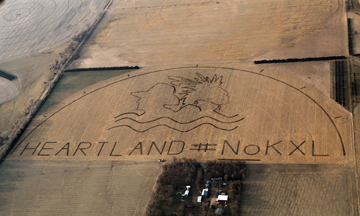
Nebraska crop art showing a cowboy and an Indian expresses rejection of proposed Keystone XL Pipeline. Photo courtesy/Lou Dematteis
Controversy over proposed Canadian tar-sands pipeline
By Talli Nauman
Native Sun News
Health & Environment Editor BRIDGER — Arvol Looking Horse blessed the Pte Ospiye spiritual camp during a prayer ceremony in Green Grass on April 12, as stormy spring weather postponed groundbreaking until the next day at the site located alongside SD Highway 34 just outside of Bridger. The camp joins the Iyuksan spiritual camp established by Shield the People with support from the Rosebud Sioux Tribe in March at Ideal, near Mission. Both camps share the purpose of warning U.S. President Obama of consequences if he fails to deny TransCanada Corp.’s request for a Presidential Permit to build the proposed Keystone XL tar-sands crude-oil (dilbit) pipeline across Lakota Territory established in the 1868 Ft. Laramie Treaty. Participants plan to join a caravan to the nation’s capital April 22-27 for a tipi encampment in the National Mall during a week of activities designed to stop the pipeline with the slogan “Protect and Reject.” Considering themselves part of the Cowboy and Indian Alliance, land holders and water rights owners involved in the activities created a giant piece of crop art in Neligh, Nebraska on April 12, to kick off the peaceful assault on Capitol Hill. Inspired by artist Richard Vollaire of the Tongva Nation, artist John Quigley supervised the 80-acre message in a cornfield located on the proposed Keystone XL Pipeline route, as well as on the Ponca Trail of Tears. The massive crop design of a cowboy and Indian warrior includes images of water and a sun representing renewable energy, with seven rays depicts the tribal tradition of protecting seven generations. “Americans always go big when they’re pushed to their limits. This image, which may well be the largest crop art ever, sends the message that the good people of the Heartland have the courage to stand up for their rights to clean water. They reject the bullying of TransCanada and will defend their land,” Quigley said in a news release from parties involved. Art Tanderup dug the image lines with his tractor following the direction of flags planted by volunteers, and an aerial image was taken of the artwork from a crop-duster plane flying at 3,000 feet. "This land has been in our family for over 100 years,” said Tanderup. “We have always been stewards of the land. The soil is very sandy here; any leak would leach into the Ogallala Aquifer contaminating our water without any concrete plan to clean up the pollution. With this crop art we are literally drawing a line in the sand and asking President Obama to stand with our families.” The Keystone XL route crosses the Ponca Trail of Tears without a proper cultural analysis from the state of Nebraska or the U.S. State Department, detractors claim. “The United States and TransCanada have consistently and intentionally disregarded the concerns of tribal nations and concerned citizens. We as tribal people have been here since the beginning of time and we have seen the best and worst of what people can create. This pipeline is certainly the worst thing that can happen to our land, our water and our people,” Aldo Seoane with the Rosebud Sioux Tribe said. Calling on Obama, Jane Kleeb of Bold Nebraska noted rural people’s reasons for rejecting the pipeline relate to natural resource security. "Our families may not contribute millions to candidates, but we do put food on America's table and can only do that with clean water that is tar-sands-free," Kleeb said. In the fight to win Obama’s favor, alliance members face stiff competition from oil industry advocates, such as the Houston-based Institute for Energy Research, funded by ExxonMobil and the Koch Brothers. Institute Founder and CEO Robert Bradley, who takes part in the American Legislative Exchange Council (ALEC) helping to influence Congressional language, contacted the Native Sun News to explain why Obama should grant the pipeline permit. The project linking Canada to Gulf Coast refineries for worldwide tar-sands crude-oil distribution would transport 830,000 barrels a day to refineries, “creating a more integrated, supply-rich international oil market,” he noted. The pipeline is more environmentally friendly than train or barge shipment, he said. It would create thousands of jobs. “Plus, by 2035, it’s estimated that the pipeline will contribute $172 billion to America's gross domestic product,” he noted. “The Obama administration should provide final approval once and for all,” Bradley concluded. Joye Braun of the Pte Ospiye Camp says donations of supplies to help dissenters can be sent c/o Toni and Byron Buffalo at 532 Chinatown, P.O. Box 863, Eagle Butte, SD 57625 Monetary donations can be earmarked for the Bridger Spiritual Camp and sent to Cheyenne River Sioux Tribe c/o Madam Treasurer Benita Clark, at P.O. Box 590 Eagle Butte, SD 57625 Pipeline activists have scheduled an informational meeting April 24, regarding a proposed 69KV electrical transmission line to serve the pipeline. The transmission line would run from Reliance to Lower Brule Sioux Reservation. The meeting was set for 12:30 p.m. Central Time at the Lower Brule casino meeting room. (Contact Talli Nauman at talli.nauman@gmail.com) Copyright permission Native Sun News
Join the Conversation